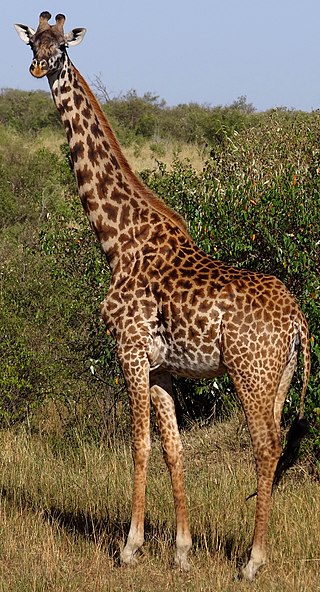
The African golden cat is a wild cat endemic to the rainforests of West and Central Africa. It is threatened due to deforestation and bushmeat hunting and listed as Vulnerable on the IUCN Red List. It is a close relative of both the caracal and the serval. Previously, it was placed in the genus Profelis. Its body size ranges from 61 to 101 cm with a 16 to 46 cm long tail.
Costus barbatus is a critically endangered species of plant native to Costa Rica.

The Masai giraffe, also spelled Maasai giraffe, and sometimes called the Kilimanjaro giraffe, is a species or subspecies of giraffe. It is native to East Africa. The Masai giraffe can be found in central and southern Kenya and in Tanzania. It has distinctive jagged, irregular leaf-like blotches that extend from the hooves to its head. The Masai giraffe is currently the national animal of Tanzania.

Costaceae, known as the Costus family or spiral gingers, is a family of pantropical monocots. It belongs to the order Zingiberales, which contains horticulturally and economically important plants such as the banana (Musaceae), bird-of-paradise (Strelitziaceae), and edible ginger (Zingiberaceae). The seven genera in Costaceae together contain about 143 known species. They are native to tropical climates of Asia, Africa, Central America, and South America. Several species are frequently found in cultivation.

Costus is a genus of herbaceous perennial plants in the family Costaceae, erected by Linnaeus in 1753. It is widespread through tropical and subtropical regions of Asia, Africa, and the Americas.

Python is a genus of constricting snakes in the Pythonidae family native to the tropics and subtropics of the Eastern Hemisphere.

Diosgenin, a phytosteroid sapogenin, is the product of hydrolysis by acids, strong bases, or enzymes of saponins, extracted from the tubers of Dioscorea wild yam species, such as the Kokoro. It is also present in smaller amounts in a number of other species. The sugar-free (aglycone) product of such hydrolysis, diosgenin is used for the commercial synthesis of cortisone, pregnenolone, progesterone, and other steroid products.
Turgenitubulus costus is a species of air-breathing land snail, a terrestrial pulmonate gastropod mollusk in the family Camaenidae. This species is endemic to Australia.
Nautilocalyx vinosus is a species of plant in the family Gesneriaceae. It is endemic to Ecuador. Its natural habitat is subtropical or tropical moist lowland forests.

Dolomiaea costus, formerly known as Saussurea costus, commonly known as costus, Indian costus,kuth, or putchuk, is a species of thistle in the genus Dolomiaea native to South Asia and China. Rishi (Hindu) mystics of Kashmir especially ate this plant. Essential oils extracted from the root have been used in traditional medicine and in perfumes since ancient times.

Costus spicatus, also known as spiked spiralflag ginger or Indian head ginger, is a species of herbaceous plant in the Costaceae family.
Costus curvibracteatus is a tropical rhizomatous perennial native to Costa Rica and Panama.

Costus malortieanus, known as Stepladder Plant, Spiral Ginger, or Spiral Flag, is a species of perennial herbaceous flowering plant in the family Costaceae. It is native to Costa Rica, Nicaragua and Honduras. Costus malortieanus is often cultivated as an ornamental plant.

Costus woodsonii, the red button ginger or scarlet spiral flag, is a species of flowering plant in the family Costaceae, native to Nicaragua, Costa Rica, Panama, and Colombia. A rhizomatous geophytic perennial, it is recommended for coastal gardens, borders, containers, and general wet, tropical garden applications. It is more widely cultivated than other species of Costus. Costus woodsonii was first described by Paul Maas in 1972 and is named for Robert Woodson of the Missouri Botanical Garden.

Costus productus, known as orange tulip ginger, dwarf orange ginger, or green mountain spiral flag, is a species of plant in the Costaceae family. Costus productus is native to South Colombia and Peru.
Costus louisii is a critically endangered species of plant endemic to Gabon.
Costus geothyrsus is a critically endangered species of plant endemic to Ecuador. It is found in only one unprotected locale, in disturbed and secondary growth forest at low elevation. The flowers are similar to those of Costus pulverulentus.

Costus montanus is a near threatened species of plant endemic to Costa Rica. It grows in moist cloud forests at middle altitudes, in the shade and along streams. Costus montanus was first described by Paul Maas in 1972.
Costus nitidus is an endangered species of plant in the family Costaceae. Its native range is Costa Rica to Panama. Costus nitidus was first described by Paul Maas in 1976. The name "nitidus" means "with a polished surface, neat, shining."












